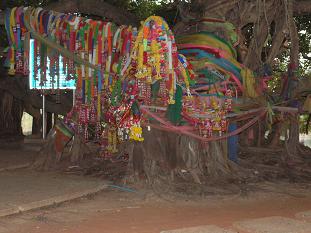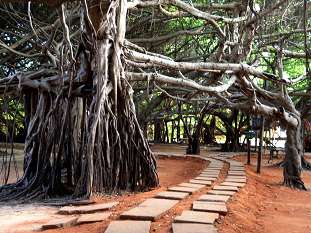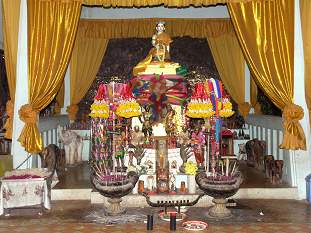|

Seen across the pond in front of the large Banyan Tree, it looks more like a small forest than a single
Golden Fig Tree. This place is a holy site as well as a popular picnic spot for locals and Thai tourists
alike.

|
|
People take coloured ribbons and Jasmine Flower Garlands to the mother trunk of the huge Banyan Tree
to pay their respect to the tree and the spirits believed living there.
|
At the northeastern edge of Phimai town the probably largest Banyan Tree in Thailand at-tracts foreigners
and local tourists alike. It is a popular excursion site for Thais. This huge Banyan Tree is a Ficus
Benghalensis, not a Ficus Benjamina as written on the information board at the site. This species of Fig
Trees is sacred in Hinduism. A close relative to the Banyan Tree is the Ficus Religiosa or the Bo-dhi Tree,
which is sacred to Buddhists, since Lord Buddha reached enleightenment sitting in the shade below such a
tree. A Bodhi Tree is always full of symbolism for mercy and charity.
Whatever species it is, the tree at Phimai is nevertheless most revered amongst the Thai people. Prove of
this are the many coloured ribbons and Jasmin Garlands at the mother trunk of the tree.
The tree covers an area of about 3'250 square metres (if you believe the informations board). Other sources
put it at only 2'300 square metres. It is believed that Phimai's large Banyan Tree is more than 350 years
old.

|
|
One of the many paths below the branches and along the many tendrils and trunks of this huge Banyan
Tree. Some tendrils may thicken to become secon-dary trunks.
|
Banyan Trees reproduce themselves by ten-drils which reach the floor from the branches of the tree and
take root to become secon-dary trunks. The new trunks stay connected to the parent tree, forming one tree
with many trunks. In a few years a single Banyan Tree can form a small forest, like the one at Phimai. It
is the symbol of eternal rebirth, the eternity of the world. The God Krishna says: I am the spirit, the
beginning, the midst and the end of the creation, I am like the Banyan among the trees.
Banyan Trees belong to the family of the mulberry plants. The fig fruits of the Banyan Trees are inedible.
The leaves as well as other parts of the plant are even slightly poisonous. In a few cases of fig tree
poision-ing of humans an irritation of mucous mem-branes was reported due to contact with the milky juice
of the plant. If parts of the plant are eaten, some stomach and intestinal troubles with stomach-ache
accompanied by vomiting may occur. So take care near fig trees.

|
|
The small shrine amongst the tree's many trunks and hundreds of tendrils, which is dedicated to HRH
Queen Prasiprachalintara who gave the tree its name.
|
A small shrine below the branches of Phimai's famous Banyan Tree is dedicated to the 5th Queen HRH
Prasiprachalintara, who visited Phimai town and the this tree in 1911 on Ja-nuary 21st. On this occasion
she named the tree Sai Ngam.
Thais regard the Banyan Trees as a favourite home for spirits - which they believe to in-habit almost
everything - and have therefore a special relationship to those trees. By re-leasing fish into the
artificial pond surround-ing the area with the tree, you can make merrit.
Sai Ngam is a popular recreation spot. Since there are a lot of people visiting this place, several
restaurants and souvenir stalls have sprung up alongside the road passing the sa-cred Sai Ngam Tree.
After visiting Phimai Hi-storical Park, Sai Ngam is the ideal place to go to next. At the restaurants
you get food and drinks for lunch. Then take a relaxing stroll below the tree to get fit again for
the visit of Phimai National Museum.
|